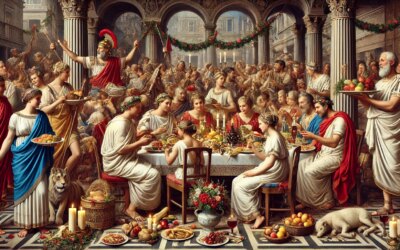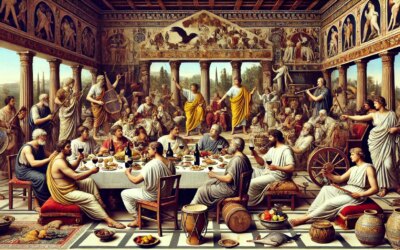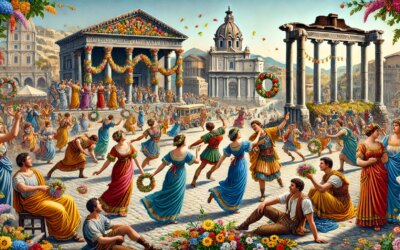Festive Flames and Flour
As the winter solstice approached, a special joy filled the air of ancient Rome. Saturnalia, the most beloved and exuberant of Roman festivals, swept the city into a week of misrule, laughter, and indulgence. In the heart of this revelry, the Roman bakery transformed from a utilitarian provider of bread to a center of celebration, preparing special loaves and sweets that echoed the spirit of the season.
The Spirit of Saturnalia
Held from December 17 to 23, Saturnalia honored Saturn, the god of agriculture and time. Originally rooted in rural rites, by the 1st century AD it had become an urban phenomenon of public feasting, role reversals, gift-giving, and unrestrained merriment.
Work was suspended, courts closed, and slaves were allowed to behave as equals—or even mock their masters. Friends exchanged tokens and candles, and homes were decked with greenery, wreaths, and light. The streets bustled with music, gambling, and theatrical performances.
Bakery at the Heart of Celebration
Food played a central role in Saturnalia, and bakeries were key suppliers of festive fare. While daily bread was a staple of Roman life, the festival demanded specialty loaves, sweetened buns, and symbolic shapes that marked the season.
In bakeries across the city, workers produced:
- Libum – A sweet cheese bread made with honey, sometimes dedicated to household gods.
- Panis festivus – Decorated holiday loaves, often shaped into suns or animals.
- Dulcia – Pastries filled with dates, nuts, and fruit preserves.
- Honey cakes – Offered as gifts and sacrifices, infused with spices and symbolism.
Amid flickering oil lamps and the warmth of the ovens, bakers donned wreaths and shared jokes, occasionally offering samples to passing revelers. The usual rush for grain and loaves turned into an atmosphere of seasonal goodwill.
Role Reversal Behind the Counter
Saturnalia’s hallmark was the inversion of social roles. In bakeries, this might play out with apprentices pretending to command their masters, or slaves wearing the pileus—the freedman’s cap—and serving customers with theatrical flair. Customers, in turn, treated laborers with unusual kindness or comic deference.
While no legal changes occurred during Saturnalia, the temporary upheaval served to reinforce social norms through ritualized release and parody. It was a time to laugh at hierarchy, indulge in excess, and emerge refreshed into the new year.
Decorating the Dolia
Roman bakeries, typically plain and practical, took on a festive air during Saturnalia. Green garlands draped from walls and counters. Wreaths of holly, ivy, and laurel hung over doorways. Candles flickered beside clay ovens, and even the great mixing vats (dolia) were polished and adorned.
Street-facing shelves displayed the season’s specialties, while patrons browsed wrapped in cloaks and garlands. Musicians sometimes played in nearby squares, adding to the atmosphere of celebration. Children, free from school, wandered by to gawk at golden loaves and sweet pastries.
Gifts from the Oven
Gift-giving was central to Saturnalia, and baked goods were a favorite option—both affordable and symbolic. Wrapped in linen cloths or ceramic dishes, families exchanged honeyed breads, cakes, and fig-filled delicacies. The act of sharing food reaffirmed bonds and invoked the festival’s agricultural roots.
Inscriptions and letters from the period mention baked gifts with affectionate greetings or puns, such as “May your Saturnalia rise like good dough” or “Sweet as honey, as the gods intended.” Bakers sometimes marked loaves with special stamps or insignia to mark the festival.
From Street Food to Banquet Table
While some purchased treats from public stalls, others hosted elaborate banquets, where baked goods played both appetizer and dessert roles. Loaves were sliced beside wine-soaked meats, dipped in olive oil, or topped with cheese and herbs.
At wealthier feasts, elaborate breads were sculpted into forms—horns of plenty, animals, or even busts of Saturn. These edible centerpieces symbolized both abundance and whimsy. Guests toasted with mulsum (honeyed wine) and ate their fill in halls lit with candles and laughter.
Saturnalia’s End—and Return to Order
As the seven-day festival waned, the city slowly returned to routine. Bakers resumed their regular schedules, slaves returned to their roles, and the streets cleared of carolers and confetti. But the memory of warmth, freedom, and community lingered—nourished by loaves baked in joy and shared in kinship.
Rome, an empire of discipline and structure, had allowed itself a moment of joyful disorder. And in the humble, flour-dusted corners of its bakeries, that spirit had risen, sweet and golden, like dough in the hearth.
A Tradition Baked into Time
Today, echoes of Saturnalia survive in winter festivals worldwide. The practice of exchanging sweets, celebrating with family, and pausing daily work to honor community draws its roots from Rome’s most delightful holiday. In every shared pastry and holiday loaf, the taste of Saturnalia endures.






